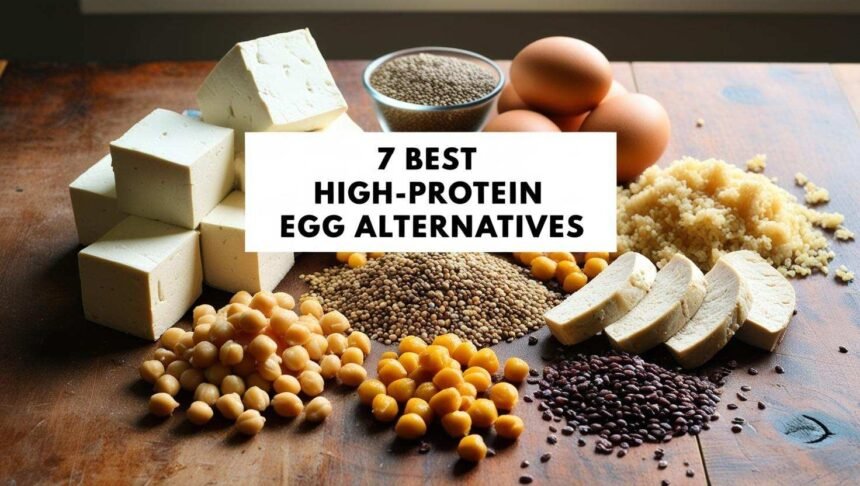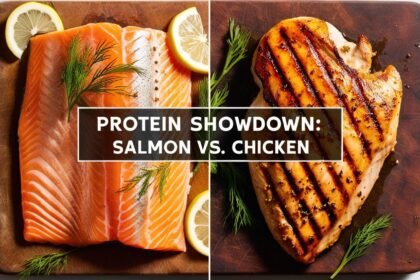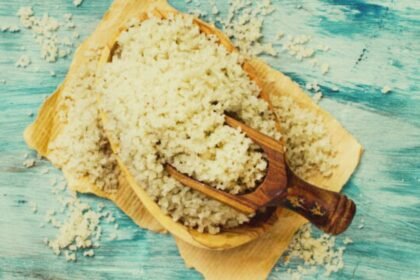Eggs are very nutritious. They are a great source of good protein, vitamins, and minerals. A large egg has about 6 grams of protein and includes all the essential amino acids.
This makes eggs a great choice for building muscle, managing weight, and staying healthy. For those who are allergic, vegan, or just want different options, there are many high-protein substitutes available.
Here are some research-supported options that offer similar nutritional benefits, based on reliable sources.
1. Tofu: The Versatile Soy-Based Protein Source
The USDA FoodData Central says that a 100-gram amount of firm tofu has about 8 grams of protein. Tofu is also a good source of calcium, iron, and potassium. One main benefit is that it contains all nine important amino acids, which makes it a full protein.
According to American Heart Association, soy-rich foods like tofu may help lower heart disease risk.
Tofu comes from peas, which many people are allergic to. Some people might worry about the plant-based estrogens found in soy.
Tip: Choose calcium-set tofu for an extra boost of bone-supporting calcium.
Meal Ideas
- Scrambled Tofu: Sauté crumbled tofu with turmeric, black salt (for an egg-like flavor), and vegetables.
- Smoothies: Add silken tofu for a creamy protein-rich smoothie.
2. Chickpea Flour: A Gluten-Free, High-Protein Alternative
According to USDA figures, one cup (92 grams) of chickpea flour has about 21 grams of protein. It also has a lot of nutritious fiber, iron, and B vitamins.
A study in Food and Function highlighted that chickpeas have a low glycemic index and can help you feel full, which may support weight control.
Some people might feel bloated because of the high fiber.
Tip: Soak the batter for a few minutes before cooking to improve digestibility.
Meal Ideas
- Vegan Omelets: Mix chickpea flour with water and spices for a protein-packed omelet.
- Baking Substitute: Use as an egg replacement in gluten-free baking.
3. Tempeh: Fermented Soy for Protein and Probiotics
The USDA says that 100 grams of tempeh has about 19 grams of protein. Tempeh is packed with bacteria, calcium, and iron.
Fermented soy foods like tempeh are easier to digest and may improve gut health because they contain probiotics, according to study published in Frontiers in Microbiology.
Tempeh is hard and has a strong taste that some people might not like.
Tip: Marinate tempeh to reduce its strong flavor.
Meal Ideas
- Stir-Fries: Sauté tempeh with vegetables and sauce.
- Breakfast Hash: Crumble tempeh and mix with potatoes and spices.
4. Seitan: The High-Protein “Wheat Meat”
Seitan offers a whopping 21 grams of protein per 100 grams (USDA). It has very little fat and carbs, but it doesn’t have enough of some important amino acids, like lysine, so it’s not a full protein.
A study in Nutrients found that plant-based meals that include seitan as a protein source can help build muscle when paired with other plant proteins.
Seitan is made from wheat gluten, so it’s not safe for people with gluten intolerance or celiac disease.
Tip: Pair seitan with lysine-rich foods like beans or lentils to make a complete protein.
Meal Ideas
- Breakfast Sausages: Shape and season seitan into sausage links.
- Grilled Seitan: Marinate and grill for a hearty protein source.
5. Lentils: Nutrient-Dense Legumes
One cup of cooked lentils gives about 18 grams of protein (USDA). Lentils are also high in fiber, iron, and calcium.
A study in Clinical Nutrition found that regularly eating legumes, like lentils, can help heart health and support weight control.
Lentils can cause gas and bloating in some individuals.
Tip: Soak lentils before cooking to reduce antinutrients and improve digestibility.
Meal Ideas
- Savory Pancakes: Blend cooked lentils with spices for pancakes.
- Lentil Scramble: Mix with vegetables for a protein-rich breakfast.
6. Hemp Seeds: Tiny Nutritional Powerhouses
Hemp seeds provide approximately 10 grams of protein per 3-tablespoon dose (USDA). They are also a good source of omega-3 and omega-6 fats.
A review in Critical Reviews in Food Science and Nutrition noted that hemp seeds have natural substances that can reduce inflammation.
Hemp seeds may have a strong, nutty flavor that not everyone enjoys.
Tip: Toast hemp seeds to enhance their flavor.
Meal Ideas
- Smoothies: Blend into smoothies for a creamy protein boost.
- Salad Topping: Sprinkle on salads for crunch and nutrition.
7. Quinoa: The Complete Protein Grain
Quinoa has all nine necessary amino acids and offers 8 grams of protein in each cooked cup, according to the USDA. It’s also rich in magnesium, iron, and dietary fiber.
A study in Plant Foods for Human Nutrition found that eating quinoa can boost digestive health and give you lasting energy.
Quinoa contains saponins, which can leave a bitter taste.
Tip: Rinse quinoa thoroughly before cooking to remove saponins.
Meal Ideas
- Breakfast Bowls: Cook quinoa with almond milk and top with fruits.
- Quinoa Patties: Combine with vegetables for protein-packed patties.
Comparative Analysis with Eggs
| Food | Protein (per 100g) | Complete Protein | Key Nutrients |
|---|---|---|---|
| Eggs | 13g | Yes | Vitamin D, choline, B12 |
| Tofu | 8g | Yes | Calcium, iron, magnesium |
| Chickpea Flour | 21g | No | Fiber, iron, B vitamins |
| Tempeh | 19g | Yes | Probiotics, calcium, iron |
| Seitan | 21g | No | Minimal fat, high gluten |
| Lentils | 18g | No | Fiber, iron, folate |
| Hemp Seeds | 10g | Yes | Omega-3, omega-6 |
| Quinoa | 8g | Yes | Magnesium, iron, fiber |
Tips for Maximizing Nutrient Absorption
- Pairing: Combine incomplete proteins like seitan or chickpea flour with complementary sources to ensure a complete amino acid profile.
- Cooking Methods: Steaming and sautéing retain more nutrients compared to boiling.
- Soaking: Soak legumes and grains to reduce antinutrients.












